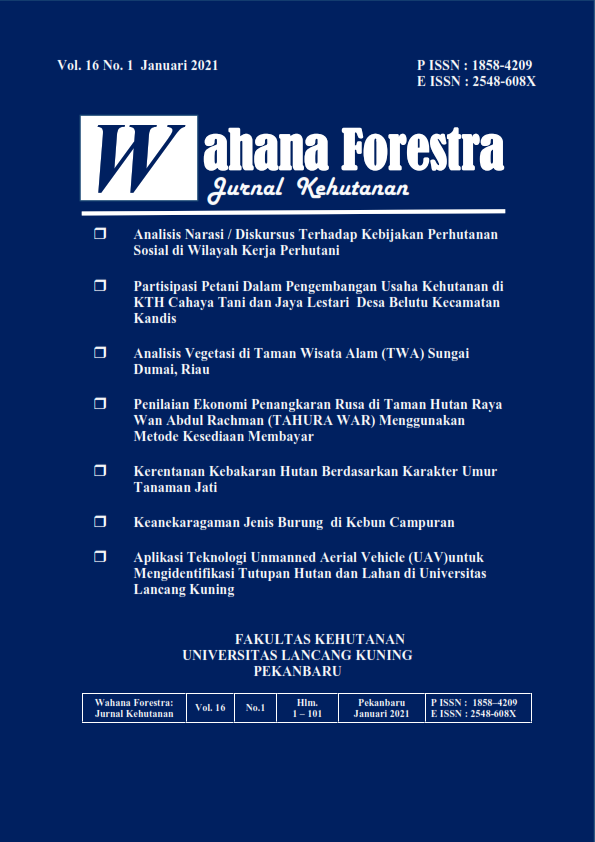ANALISIS VEGETASI DI TAMAN WISATA ALAM (TWA) SUNGAI DUMAI, RIAU
DOI:
https://doi.org/10.31849/forestra.v16i1.5720Keywords:
NDVI, TWA Sungai Dumai, Vegetation densityAbstract
TWA Sungai Dumai is a tourist forest area and ensuring the preservation of natural potential. However, there are problems that can disrupt the sustainability of it, including forest and land fires and conversion of land use to agriculture and oil palm plantations. Until now, there is no vegetation analysis using satellite imagery in TWA Sungai Dumai, so it is important to do so that can be managed sustainably. This study classification of vegetation density classes which are presented in the form of a vegetation density class map in it. This research uses Landsat-8 OLI / TIRS images from October 2017 and October 2020 which are processed to determine density class using Normalized Difference Vegetation Index algorithm. The vegetation density class with the highest area in 2017 was the vegetation density class (2380,832 ha or 66,819% of the total area), while the lowest area was the non-vegetation class (75,737 ha or 2,126% of the total area). The vegetation density class with the highest area in 2020 in TWA Sungai Dumai is dense vegetation density class (3205,039 ha or 89,950% of the total area), while the lowest area is non-vegetation class (1,637 ha or 0.046% of the total area)
References
Alikodra, HS. 2002. Pengelolaan Satwa Liar Jilid 1. Yayasan Penerbit Fakultas Kehutanan IPB. Bogor.
Beehler, BM., TK. Pratt dan DA. Zimmerman. 2001. Burung-burung di Kawasan Papua. Puslitbang Biologi – LIPI. Bogor
Bibby, C., M. Jones, dan S. Marsden. 2000. Teknik-teknik Ekspedisi Lapangan Survei Burung. SMKG Mardi Yuana. Bogor
Hadinoto. A. Mulyadi, YI. Siregar. 2012. Keanekragaman Jenis Burung di Hutan Kota Pekanbaru. Jurnal Ilmu Lingkungan. Vol. 6 (1) : 25-42
Hadinoto, E.Suhesti. 2017. Species Diversity and Bird Feed in Residential Complex. Di dalam: International Conference on Environment and Technology (IC-Tech). IOP Conf. Series: Earth and Environmental Science 97 (2017) 012001
Hernowo, JB. 1989. Suatu Tinjauan terhadap Keanekaragaman Jenis Burung dan Peranannya di Hutan Lindung Bukit Suharto, Kalimantan Timur. Media Konservasi. Vol.II (2), Januari 1989. Jurusan Konservasi Sumberdaya Hutan, Fakultas Kehutanan IPB. Bogor.
Holmes, D., dan S. Nash. 1999. Burung-burung di Sumatera dan Kalimantan. Puslitbang Biologi – LIPI. Bogor
MacKinnon, J., K. Philip dan V. Balen. 2010. Seri panduan Lapangan Burung-Burung Sumatera, Kalimantan, Jawa dan Bali. Puslitbang Biologi – LIPI. Bogor
Nandika D. 2005. Hutan bagi ketahanan nasional. Universitas Muhammadiyah Surakarta.
Odum, EP. 1998. Dasar-Dasar Ekologi. 1998. Gajah Mada University Prees Yogyakarta
Rusmendro, H. 2009. Perbandingan Keanekaragaman Burung Pada Pagi dan Sore Hari Di Empat Tipe Habitat Di Wilayah Pangandaran, Jawa Barat. Vis Vitalis, Vol. 02 No. 1, Maret 2009. Fakultas Biologi Universitas Nasional, Jakarta
Shannaz, J., P.jepson dan Rudyanto. 1995. Burung-Burung Terancam Punah di Indonesia. PHPA/BirdLife International-Indonesia Programe. Bogor
Soeratmo, FG. 1979. Konservasi Alam dan Pengelolaan Margasatwa Bagian II (Tingkah Laku Margasatwa). Sekolah Pasca Sarjana Institut Pertanian Bogor. Bogor.
Widodo, W. 2006. Kemelimpahan dan Sumber Pakan Burung-burung di Taman Nasional Manusela, Seram, Maluku Tengah. Biodiversitas 56 Vol. 7, No. 1, Januari 2006. Pusat Penelitan Biologi, Lembaga Ilmu Pengetahuan Indonesia (LIPI), Cibinong-Bogor.






